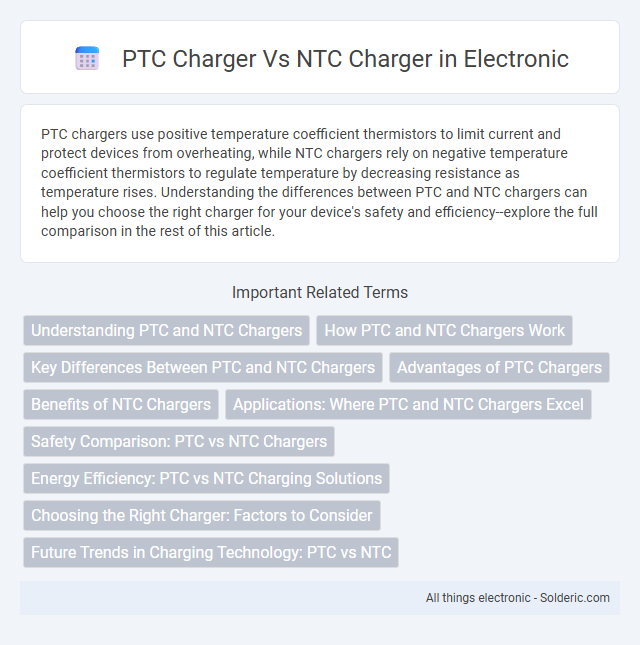PTC chargers use positive temperature coefficient thermistors to limit current and protect devices from overheating, while NTC chargers rely on negative temperature coefficient thermistors to regulate temperature by decreasing resistance as temperature rises. Understanding the differences between PTC and NTC chargers can help you choose the right charger for your device's safety and efficiency--explore the full comparison in the rest of this article.
Comparison Table
| Feature | PTC Charger | NTC Charger |
|---|---|---|
| Full Form | Positive Temperature Coefficient | Negative Temperature Coefficient |
| Function | Limits current by increasing resistance with temperature rise | Limits current by decreasing resistance with temperature rise |
| Temperature Sensitivity | Resistance increases as temperature increases | Resistance decreases as temperature increases |
| Usage in Chargers | Used for over-current protection and self-regulating heat control | Used for temperature sensing and inrush current limiting |
| Protection | Automatic current limiting during overheating | Provides temperature feedback for thermal management |
| Response Time | Moderate, depends on heating element | Fast, ideal for temperature sensing |
| Common Materials | Polymeric ceramic compound | Ceramic semiconductor |
| Cost | Generally low to moderate | Generally low |
| Typical Applications | Battery chargers, motor protection | Temperature sensing, inrush current limiters |
Understanding PTC and NTC Chargers
PTC chargers use Positive Temperature Coefficient thermistors that increase resistance as temperature rises, providing self-regulating overcurrent protection ideal for electronic devices. NTC chargers incorporate Negative Temperature Coefficient thermistors, which decrease resistance with rising temperature, allowing for efficient inrush current limiting during device startup. The choice between PTC and NTC chargers depends on specific application requirements such as thermal regulation, energy efficiency, and safety standards.
How PTC and NTC Chargers Work
PTC chargers use Positive Temperature Coefficient thermistors that increase resistance as the temperature rises, effectively limiting current to prevent overheating. NTC chargers employ Negative Temperature Coefficient thermistors where resistance decreases with temperature, allowing higher current flow initially and stabilizing as the device warms up. Your choice between PTC and NTC chargers impacts thermal management and overall charging safety.
Key Differences Between PTC and NTC Chargers
PTC chargers use positive temperature coefficient thermistors that increase resistance as temperature rises, providing inherent overcurrent protection, while NTC chargers use negative temperature coefficient thermistors that decrease resistance with temperature to limit inrush current. PTC chargers typically offer faster recovery after overheating and better self-regulation, whereas NTC chargers excel in reducing initial surge current during power-up. Understanding these distinctions helps optimize Your device's charging safety and efficiency based on specific thermal and current requirements.
Advantages of PTC Chargers
PTC chargers offer superior thermal protection by automatically limiting current when temperature rises, enhancing safety and preventing overheating. Their self-regulating properties reduce the risk of damage to your device and charger, leading to longer lifespan and reliability. Efficiency improvements in PTC chargers also result in faster, more consistent charging compared to NTC chargers.
Benefits of NTC Chargers
NTC chargers provide superior temperature regulation by using negative temperature coefficient thermistors that decrease resistance as temperature rises, ensuring efficient thermal management and reduced overheating risks. These chargers enhance battery longevity by preventing excessive heat buildup during charging cycles, which protects sensitive battery components and improves overall safety. Their adaptive response to temperature changes contributes to energy efficiency and consistent charging performance across varying environmental conditions.
Applications: Where PTC and NTC Chargers Excel
PTC chargers excel in applications requiring overcurrent protection and temperature regulation, such as electric vehicle battery systems and portable electronic devices, due to their self-regulating heating elements. NTC chargers are ideal in scenarios demanding precise temperature sensing and control, including intelligent power adapters and high-performance battery management systems. The distinct thermal properties of PTC and NTC components make them suitable for optimizing charging efficiency and safety across various consumer electronics and industrial power supplies.
Safety Comparison: PTC vs NTC Chargers
PTC chargers incorporate Positive Temperature Coefficient resistors that increase resistance as temperature rises, providing enhanced overcurrent protection and preventing overheating, which significantly improves safety during charging. NTC chargers use Negative Temperature Coefficient thermistors that decrease resistance with temperature rise, primarily regulating inrush current but offering less effective protection against sustained overheating. For your devices, choosing a PTC charger ensures more reliable thermal safety and reduces the risk of damage or fire hazards compared to NTC chargers.
Energy Efficiency: PTC vs NTC Charging Solutions
PTC chargers use Positive Temperature Coefficient thermistors that increase resistance as temperature rises, improving energy efficiency by reducing current flow and minimizing heat generation. In contrast, NTC chargers with Negative Temperature Coefficient thermistors initially allow higher current, which decreases as temperature increases, often resulting in higher energy loss and heat dissipation. PTC charging solutions typically offer better thermal management and energy efficiency compared to NTC-based chargers, making them more suitable for sustainable applications.
Choosing the Right Charger: Factors to Consider
When selecting between a PTC charger and an NTC charger, consider factors such as temperature regulation efficiency, charging speed, and device compatibility to ensure optimal performance. PTC chargers offer self-regulating temperature control with increased safety, while NTC chargers provide variable resistance for gradual temperature changes. Your choice should align with the specific thermal management needs and charging requirements of your electronic device.
Future Trends in Charging Technology: PTC vs NTC
Future trends in charging technology indicate a shift toward PTC (Positive Temperature Coefficient) chargers due to their enhanced safety features and ability to self-regulate temperature, reducing the risk of overheating. NTC (Negative Temperature Coefficient) chargers, while effective in temperature sensing, are gradually being outpaced by PTC chargers that offer more reliable thermal protection and longer device lifespan. Your choice in charging solutions will benefit from adopting PTC technology as it aligns with advancements in smart, energy-efficient, and safer charging infrastructures.
PTC charger vs NTC charger Infographic

 solderic.com
solderic.com